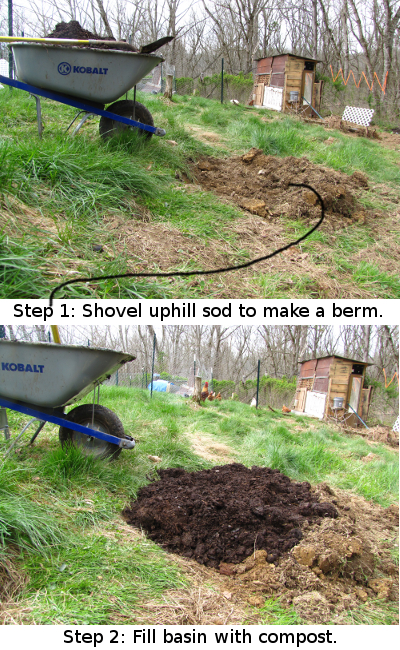
Hardy almonds
 Almonds are one of my new
favorite foods, so I decided to see if we could grow them.
Traditionally, almonds are grown in the sunny south, especially in
California where summers are dry, but orchardists have recently
developed hardy almonds that can live all the way north to zone
5. We chose Alenia (Prima) and Dessertniy (Bounty) because they
are late-blooming (which means less likely to succumb to our frequent
spring frosts), have thin shells, and are supposed to have tasty
nuts. (Bitterness can be a problem with some almond varieties.)
Almonds are one of my new
favorite foods, so I decided to see if we could grow them.
Traditionally, almonds are grown in the sunny south, especially in
California where summers are dry, but orchardists have recently
developed hardy almonds that can live all the way north to zone
5. We chose Alenia (Prima) and Dessertniy (Bounty) because they
are late-blooming (which means less likely to succumb to our frequent
spring frosts), have thin shells, and are supposed to have tasty
nuts. (Bitterness can be a problem with some almond varieties.)
The main problem people
report with growing almonds in the east is fungal diseases that result
from our wet summers. To nip fungi in the bud, we've sited our
new trees in the sunniest part of the yard and given them a bit more
air space than they require (planting them 20 feet apart rather than
the rated 10 to 15 feet.) Unfortunately, this area is on a slope,
but I built cepa terraces for our trees to make them
easier to tend and to capture rainwater for the roots.
Those of you with the
keenest eyes have probably noticed that our new almond beds are in the chicken pasture. We moved our flock on
to pasture two on Friday, giving me some breathing room to plant
almonds and grapes in the old pasture. Before rotating the
chickens back to this pasture, we'll make some simple tree cages out of
chicken wire to keep the birds from scratching up my new plantings.
Want more in-depth information? Browse through our books.
Or explore more posts by date or by subject.
About us: Anna Hess and Mark Hamilton spent over a decade living self-sufficiently in the mountains of Virginia before moving north to start over from scratch in the foothills of Ohio. They've experimented with permaculture, no-till gardening, trailersteading, home-based microbusinesses and much more, writing about their adventures in both blogs and books.
Want to be notified when new comments are posted on this page? Click on the RSS button after you add a comment to subscribe to the comment feed, or simply check the box beside "email replies to me" while writing your comment.

They contain 4-8 mg of hydrogen cyanide each, which is very toxic (200 mg is lethal for an adult).
Bitter almonds contain a precursor to hydrogen cyanide; amygdalin which releases HCN when catalyzed by an appropriate enzyme (which is present in out intenstine and in some foods).